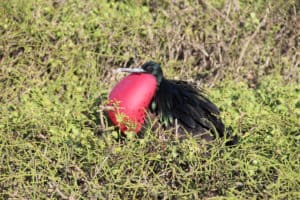
In 2014, Ralph and I were able to visit the Galapagos Islands with Wilderness Travel. I expected that we would see some amazing wildlife and landscapes, but I had no idea how unique our trip would be. Visitors to the islands usually have to chose between the eastern or western group of islands. However, a friend who knew about which animals lived on each cluster of islands encouraged us to visit both groups. We decided to make our trip a two-week adventure—living on the romantic Mary Ann, a three-masted sailing vessel.*
Our leisurely days
Generally our days began with an early walk on an island or two> Then we came back to the ships for a delicious breakfast of fruit, breads, and eggs. Depending on where we had sailed, our next stop might have been another island visit.
After that workout, came a hearty lunch; then a swim, snorkel, or kayak period in the afternoon. Generally by that time of day, we were ready for a nap, followed by dinner (often fresh seafood) and conversation. Sometimes the boat moved to a different island during the day, usually it did so at night.
Unique wildlife
For most of us, it was not just seeing all of the exotic wildlife, it was the fact that most of the birds and other animals were not afraid of us. They didn’t run or fly away when we approached (the number of boats and visitors is strictly controlled by the Ecuadoran government.) That allowed for wonderful viewing and photography!

The Frigatebird
One of my favorites was the Frigatebird (Fregata magnificens). While this strange looking bird is not endemic to the Galapagos, it is usually only found on the America’s Pacific and Atlantic coasts from Georgia and California to Ecuador and Uruguay, and on the nearby islands.
It would be hard not to love these odd-looking birds. The male shown here is doing a courtship display. When he tries to show his dominance over other males, and woo a female, he inflates his gular sac, which then puffs out into the heart-shape.
He also clacks his beak, which resonates in the sac like a drum beat. Researchers have observed that the more adept the male is at his drumming routine—faster and longer—the more successful he will be at attracting females. And if that isn’t enough to attract a female, he may even shake his head or his body disco-style.
Frigatebirds are not considered to be at risk as a species—but we were only able to see them in great number because it was mating season. The rest of the year, they may spend months in the air–only swooping down to the sea for moments to capture a meal.
There’s no doubt about it, this is a once-in-a-lifetime trip!
*The Mary Ann is used by various Galapagos tour companies. Though the crew does use the sails a bit of the time, during most of our cruise, we were powered by motor.
